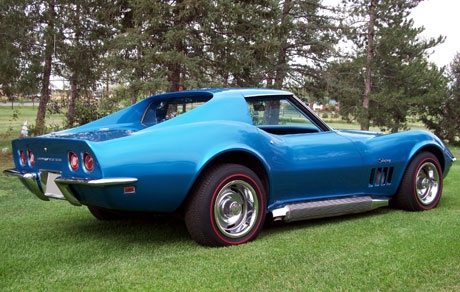The 1968 C3 Corvette was derived from Larry Shinoda’s Mako Shark show car. For 1969, there were small visual differences—principally the word Stingray added to the front fenders, and the door release mechanism was designed around what was a finger hold in 1968, eliminating the separate release button. Troublesome teething issues were more or less ironed out, a new 350-ci small-block engine was introduced, and sidepipe exhausts were available for the new body style, after being dropped in 1968.
In all there were seven engines offered. There were two small-blocks—the base 350/300 and the 350/350 L78—and five big-block engines. These were the 427/390 L36, 427/400 tri-carb L68, 427/435 tri-carb L71, 427/435 tri-carb L89 with the aluminum heads, and the monster 427/430 (ha! try 560 hp) L88. There was also the ZL1 package, which added an all-aluminum L88 engine and doubled the $4,781 price of the base coupe by adding a whopping $4,718. Not surprisingly, perhaps, there were only two of these.
The best daily driver packages are considered by many to be the L36 and L68 427-ci big-blocks, and this car is the 400-hp L68.
It is described as a numbers-matching, frame-off restoration of a very straight California car with side exhaust, and it’s one of 2,072 produced in 1969.
SCM Analysis
Detailing
| Vehicle: | 1969 427/400 Coupe |
| Years Produced: | 1969 |
| Number Produced: | 2,072 L68 coupe & convertible |
| Original List Price: | $5,561 |
| SCM Valuation: | $34,000–$70,000 |
| Tune Up Cost: | $350 |
| Distributor Caps: | $12 |
| Chassis Number Location: | VIN tag attached to driver’s A- pillar, transmission case, engine pad and frame |
| Engine Number Location: | On block in front of right cylinder head |
| Club Info: | National Corvette Restorers Society |
| Website: | www.ncrs.org |
| Alternatives: | 2001–05 Z06 1988–91 Callaway B2K 1995 ZR-1 |
| Investment Grade: | C |
This car sold for $44,520, including buyer’s premium, at Mecum’s Fall High Performance Auction in St. Charles, Illinois, on October 2, 2009.
Finished in LeMans Blue over a bright blue interior, the 400-hp, 4-speed, side-exhaust coupe appeared to have been treated to a meticulous body-off-restoration. One that probably cost more than the selling price. The owner’s description to Mecum makes mention of it being an “original, numbers-matching… engine,” whatever that means. Perhaps the engine is original to the car, or merely date-coded correctly for that time period? In any case, such vague language is something potential purchasers with any notion of a return on their investment should note very carefully. Frankly, I prefer the statement, “This is the original engine that came in the car.”
The 400-horsepower Corvette engines were fairly rare, with 2,101 made in 1967, 1,932 in 1968, and 2,072 in 1969. These long blocks started life in Tonawanda, New York, as 427/390 units, with a single Holley 3811 4-barrel carb. Tank sheets show the option as being converted to 400 hp by swapping out the cast-iron intake with the single 4-barrel Holley and replacing it with a lighter-weight Winter’s aluminum casting, with a tri-power, oval port intake and three Holley 2-barrels flowing about 1,100 cfm.
A tale of torque and civility
I have owned or driven Corvettes from each of the model years in which the 427/400 version was produced, with both automatic and 4-speed transmissions. These are excellent drivers, with the torque of large-displacement, big-block motors and the civility of hydraulic-lifter, lower-redline, 2-bolts. The legendary 435-hp motors had the same Holley 2300-series 3659 and 60s, but the intake had rectangular ports to mate with solid-lifter heads, a heavy-duty high-lift cam and crank, and higher-compression pistons and rods.
Buyers and collectors alike seem to want side-exhaust cars. My ’67 435 has them and yes, they make a lot of noise. In fact, the Oregon DEQ used my car as their “standard” for the 1967 435s with sidepipes, listing left and right noise levels over 100 dB. The option first appeared on Corvette order forms midway through 1965. Only 3% (759) of buyers ordered RPO N14 in 1965, 13% (3,617) bought it in 1966, and 18% (4,209) in 1967.
Unfortunately, sidepipes could not have come on this car from the factory, as the VIN of 2,554 was built during September 1968; production of sidepipe-equipped 1969 Corvettes started in mid-December, which is closer to VIN 10,000.
Original sidepipes were a bargain
The cost of the sidepipe option remained at $131.65 through the mid-years. For some reason, GM did not offer the N14 option in 1968 but took orders for 4,355 in 1969, the last time it was to be available as an RPO. The cost in 1969 was up $15.80 to a whopping $147.45.
To put things in perspective, the reproduction parts kit to add or replace sidepipes would cost close to $3,000 now, not including labor. That’s 50%–60% of the base cost of the Corvette itself when new.
So what we have is a restored example of almost the last of the real sharks, a ’69 427 3×2 with owner-inspired N.O.S. GM side exhausts, a seemingly new interior, 4-speed, radio, Positraction, and “the original, numbers-matching motor.” For what the new owner paid, he could part this car out and come out ahead, or he could drive it and have a smile for every mile. That would be my preference, so I’d call it well bought. (Introductory description courtesy of Mecum Auctions.
